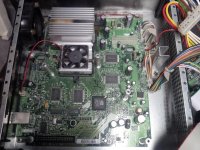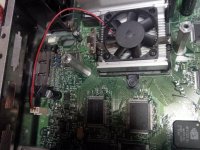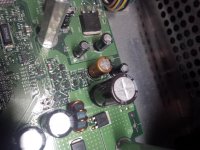winteriscoming
Champion
Recent Chihiro discussions have lead me to believe they might be more susceptible to failure than I had thought. Apparently a common failure is that the GPU fan can die and the GPU cooks itself and the surrounding PCB, making it virtually impossible to repair.
What about adding in an external GPU fan monitor that shuts down the Chihiro if there's a fault?
It seems like it could be a relatively simple and cheap Arduino project. Here's an example of reading a fan's RPM with an Arduino.
So the circuit could involve wiring up the fan's signal wire to the Arduino and routing power (maybe just 12v?) to the Chihiro though something like a relay. The Arduino would be responsible for allowing the Chihiro to power on. If it senses a fault in the fan, it kills the power.
Questions:
1. What type of fan is currently in use for the GPU? Is it one that has a signal wire? If so, does the Chihiro require that the signal wire is hooked up in order to boot (also if it does need it, why doesn't it monitor and shutdown in a failure!? )? If not, is there an adequate replacement that does have a signal wire that could be used by the Arduino?
)? If not, is there an adequate replacement that does have a signal wire that could be used by the Arduino?
2. What has to be done to sufficiently kill Chihiro power and avoid damage? Is cutting 12v sufficient? Do all three (3.3v, 5v, and 12v) need to be cut to safely turn it off in a fault scenario? I wouldn't want to go all the way back to cutting AC since the Arduino would likely need to be powered by the power supply using that same AC.
What are other failure points that merit maintenance? I have read about removing a memory cap, but haven't found a clear guide on which cap to remove.
What about adding in an external GPU fan monitor that shuts down the Chihiro if there's a fault?
It seems like it could be a relatively simple and cheap Arduino project. Here's an example of reading a fan's RPM with an Arduino.
So the circuit could involve wiring up the fan's signal wire to the Arduino and routing power (maybe just 12v?) to the Chihiro though something like a relay. The Arduino would be responsible for allowing the Chihiro to power on. If it senses a fault in the fan, it kills the power.
Questions:
1. What type of fan is currently in use for the GPU? Is it one that has a signal wire? If so, does the Chihiro require that the signal wire is hooked up in order to boot (also if it does need it, why doesn't it monitor and shutdown in a failure!?
 )? If not, is there an adequate replacement that does have a signal wire that could be used by the Arduino?
)? If not, is there an adequate replacement that does have a signal wire that could be used by the Arduino?2. What has to be done to sufficiently kill Chihiro power and avoid damage? Is cutting 12v sufficient? Do all three (3.3v, 5v, and 12v) need to be cut to safely turn it off in a fault scenario? I wouldn't want to go all the way back to cutting AC since the Arduino would likely need to be powered by the power supply using that same AC.
What are other failure points that merit maintenance? I have read about removing a memory cap, but haven't found a clear guide on which cap to remove.





 testing which is better at cooling shouldn't be a problem... I need to dig some old Xboxes out of storage at some point.. I'm open to suggestions of easily repeatable, graphically intensive game sections to test temps under load.
testing which is better at cooling shouldn't be a problem... I need to dig some old Xboxes out of storage at some point.. I'm open to suggestions of easily repeatable, graphically intensive game sections to test temps under load.